Token coin
In numismatics, token coins or trade tokens are coin-like objects used instead of coins. The field of token coins is part of exonumia and token coins are token money. Tokens have a denomination either shown or implied by size, color or shape. "Tokens" are often made of cheaper metals: copper, pewter, aluminium, brass and tin were commonly used, while bakelite, leather, porcelain, and other less durable materials are also known.
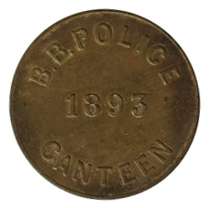
A key point of difference between a token coin and a legal tender coin is that the latter is issued by a governmental authority and is freely exchangeable for goods. However, a token coin typically has a much more limited use and is often issued by a private company, group, association or individual. In the case of "currency tokens" issued by a company but also recognized by the state there is a convergence between tokens and currency.
Currency tokens
Currency tokens issued by a company sometimes ceased to be merely "trade" tokens when they were sanctioned by a local government authority: perhaps due to a severe shortage of money or the government's inability to issue its own coinage. In effect, the organization behind the tokens became the regional bank.

A classic example of this is the Strachan and Co trade tokens of East Griqualand in South Africa, which were used as currency by the indigenous people in the region from 1874. Their initial success resulted from the scarcity of small change in that remote region at that time.
Similarly, in times of high inflation, tokens have sometimes taken on a currency role. Examples of this are Italian and Israeli telephone tokens, which were always good for the same service (i.e. one phone call) even as prices increased. New York City Subway tokens were also sometimes accepted in trade, or even in parking meters, since they had a set value.
Trade tokens or barter tokens
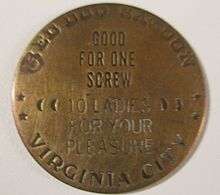
Coin-like objects from the Roman Empire called spintriae have been interpreted as an early form of token. Their functions are not documented, but they appear to have been brothel tokens or possibly gaming tokens.[1]
Medieval English monasteries issued tokens to pay for services from outsiders. These tokens circulated in nearby villages, where they were called "Abbot's money". Also, counters called jetons were used as small change without official blessing.[2]
From the 17th to the early 19th century in the British Isles and North America, tokens were commonly issued by merchants in times of acute shortage of coins of the state. These tokens were in effect a pledge redeemable in goods, but not necessarily for currency. These tokens never received official sanction from government but were accepted and circulated quite widely.
In England, the production of copper farthings was permitted by royal licence in the first few decades of the 17th century, but production ceased during the English Civil War and a great shortage of small change resulted. This shortage was felt more keenly because of the rapid growth of trade in the towns and cities, and this in turn prompted both local authorities and merchants to issue tokens.
These tokens were most commonly made of copper or brass, but pewter, lead and occasionally leather tokens are also found. Most were not given a specific denomination and were intended to substitute for farthings, but there are also a large number of halfpenny and sometimes penny tokens. Halfpenny and penny tokens usually, but not always, bear the denomination on their face.
Most such tokens show the issuer's full name or initials. Where initials were shown, it was common practice to show three initials: the first names of husband and wife and their surname. Tokens would also normally indicate the merchant establishment, either by name or by picture. Most were round, but they are also found in square, heart or octagonal shapes.
Thousands of towns and merchants issued these tokens from 1648 until 1672, when official production of farthings resumed, and private production was suppressed.
There were again coin shortages in the late 18th century, when the British Royal Mint almost ceased production. Merchants once again produced tokens, but they were now machine made and typically larger than their 17th century predecessors, with values of a halfpenny or more. While many were used in trade, they were also produced for advertising and political purposes, and some series were produced for the primary purpose of sale to collectors. These tokens are usually known as Conder tokens, after the writer of the first reference book on them.
These were issued by merchants in payment for goods with the agreement that they would be redeemed in goods to an equivalent value at the merchants' own outlets. The transaction is therefore one of barter, with the tokens playing a role of convenience, allowing the seller to receive his goods at a rate and time convenient to himself, and the merchant to tie the holder of the token coin to his shop. Trade tokens often gradually changed into barter tokens, as evidenced by the continued circulation of former trade tokens when the need for their use had passed.
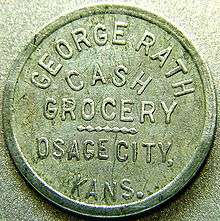
In the United States of America, Hard times tokens issued from 1832 to 1844 and Civil War tokens issued in the 1860s made up for shortages of official money.[3]
Because of weight, the U.S. Treasury Department does not ship coins to the Armed Forces serving overseas, so Army and Air Force Exchange Service officials chose to make pogs in denominations of 5, 10, and 25 cents. The pogs are about 38 mm (1.5816" to be exact) in diameter, and feature various military-themed graphics.
The collecting of trade tokens is part of the field of exonumia, and includes other types of tokens, including transit tokens, encased cents, and many others. In a narrow sense, trade tokens are "good for" tokens, issued by merchants. Generally, they have a merchant's name or initials, sometimes a town and state, and a value legend (such as "good for 5¢" or other denomination) somewhere on the token. Merchants that issued tokens included general stores, grocers, department stores, dairies, meat markets, drug stores, saloons, bars, taverns, barbers, coal mines, lumber mills and many other businesses. The era of 1870 through 1920 marked the highest use of "trade tokens" in the United States, spurred by the proliferation of small stores in rural areas. There were thousands of small general and merchandise stores all over the United States, and many of them used trade tokens to promote trade and extend credit to customers. Aluminum tokens almost always date after 1890, when low-cost production began.
Slot machine tokens
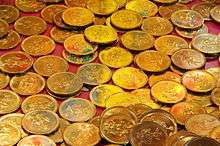
Metal token coins are used in lieu of cash in some coin-operated arcade games and casino slot machines.
Money is exchanged for the token coins or chips in a casino at the casino cage, at the gaming tables, or at a slot machine and at a cashier station for slot token coins. The tokens are interchangeable with money at the casino. They generally have no value outside of the casino.
After the increase in the value of silver stopped the circulation of silver coins around 1964, casinos rushed to find a substitute, as most slot machines at that time used that particular coin. The Nevada State Gaming Control Board consulted with the U.S. Treasury, and casinos were soon allowed to start using their own tokens to operate their slot machines. The Franklin Mint was the main minter of casino tokens at that time.
In 1971, many casinos adopted the Eisenhower Dollar for use in machines and on tables. When the dollar was replaced with the Susan B. Anthony dollar in 1979, most casinos reinstituted tokens, fearing confusion with quarters and not wishing to extensively retool their slot machines. Those casinos which still use tokens in slot machines still use Eisenhower-sized ones.
In many jurisdictions, casinos are not permitted to use currency in slot machines, necessitating tokens for smaller denominations.
Tokens are being phased out by many casinos in favor of coinless machines which accept banknotes and print receipts for payout. (These receipts - often nicknamed "TITOs" for Ticket-in, ticket-out, can also be inserted into the machines.) In video arcades, they are also being phased out in favor of magnetic cards, which can also count how many tickets one has, allowing arcades to also do away with paper tickets.
Staff tokens
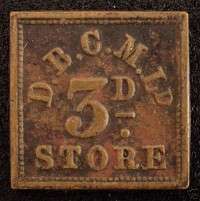
Staff tokens were issued to staff of businesses in lieu of coins. In the 19th century the argument supporting payment to staff was the shortage of coin in circulation, but in reality employees were forced to spend their wages in the company's stores at highly inflated prices—resulting in an effective dramatic lowering of their actual salary and disposable income.
Other uses
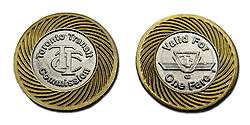
_Bridge_Line_%26_Fare_Tokens.jpg)
Railways and public transport agencies used fare tokens for years, to sell rides in advance at a discount, or to allow patrons to use turnstiles geared only to take tokens (as opposed to coins, currency, or fare cards).

- Car washes – Though their use has decreased in favor of coins and credit cards.
- Video arcades
- Parking garages
- Pay toilets
- Subways
- Shopping cart rental
- Public telephone booths in countries with unstable currency were usually configured to accept tokens sold by the telephone company for variable prices. This system was in effect in Brazil until 1997 when magnetic cards were introduced. The practice was also recently discontinued in Israel, leading to a trend of wearing the devalued tokens as necklaces.
- Fast food restaurants – Often given to children to collect and redeem for prizes.
- Commemorative coins have been produced with no monetary value to distribute by a company, country or organization.
In North America tokens were originally issued by merchants from the 18th century in regions where national or local colonial governments did not issue enough small denomination coins for circulation. They were later used to create a monopoly; to pay labor; for discounts (pay in advance, get something free or discounted); or for a multitude of other reasons. In the United States, a well-known type is the wooden nickel, a five-cent piece distributed by cities to raise money for their anniversaries in the 1940s to 1960s.
Local stores, saloons and mercantiles would issue their own tokens as well, usable only in their own shops. Railways and public transport agencies have used fare tokens for years to sell rides in advance at a discount. Many transport organizations still offer their own tokens for bus and subway services, toll bridges, tunnels, and highways, although the use of computer-readable tickets has replaced these in most areas.
Churches used to give tokens to members passing a religious test prior to the day of communion, then required the token for entry. While mostly Scottish Protestant, some U.S. churches used communion tokens. Generally, these were pewter, often cast by the minister in church-owned molds. Replicas of these tokens have been made available for sale at some churches recently.
See also
References and sources
- References
- Thomas A. McGinn, The Economy of Prostitution in the Roman World (University of Michigan Press, 2004), p. 86.
- British Tokens And Their Values, Peter Seaby et al, page 7 of the second edition.
- A Guide Book of United States Coins, R. S. Yeoman and Kenneth Bresset, pages 372 and 376 of the 61st edition
- Sources
- "Church Tokens", New York Times, 11 April 1993
Further reading
- Angus, Ian. Coins & Money Tokens. London: Ward Lock, 1973. ISBN 0-7063-1811-0
External links
- Exonumia
- The Conder Tokens Enthusiast - resources regarding 18th Century English Provincial token coinage
- A reference site on AAFES pogs: tokens currently in use by US armed forces overseas.
- National Museum of Australia 1865 Australian cuprous halfpenny trading token.
- New York City Subway Tokens
- Museum of English Rural Life Trade Tokens